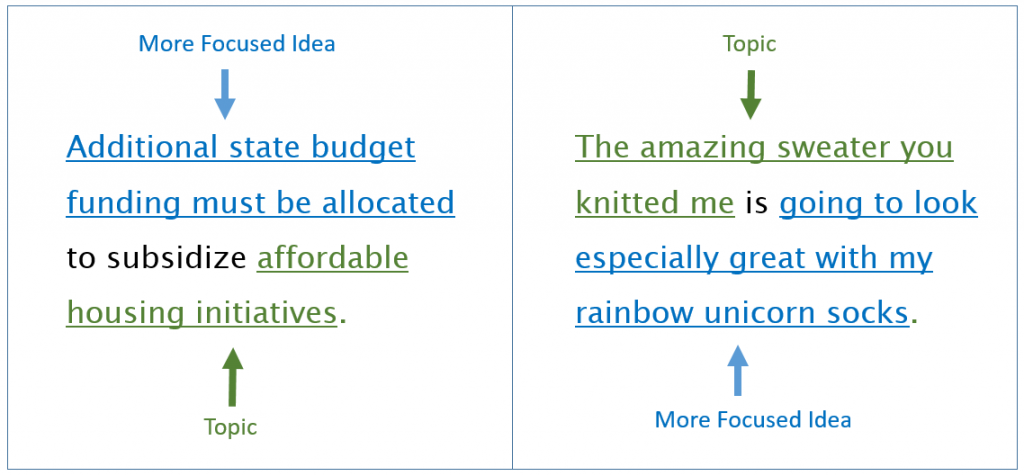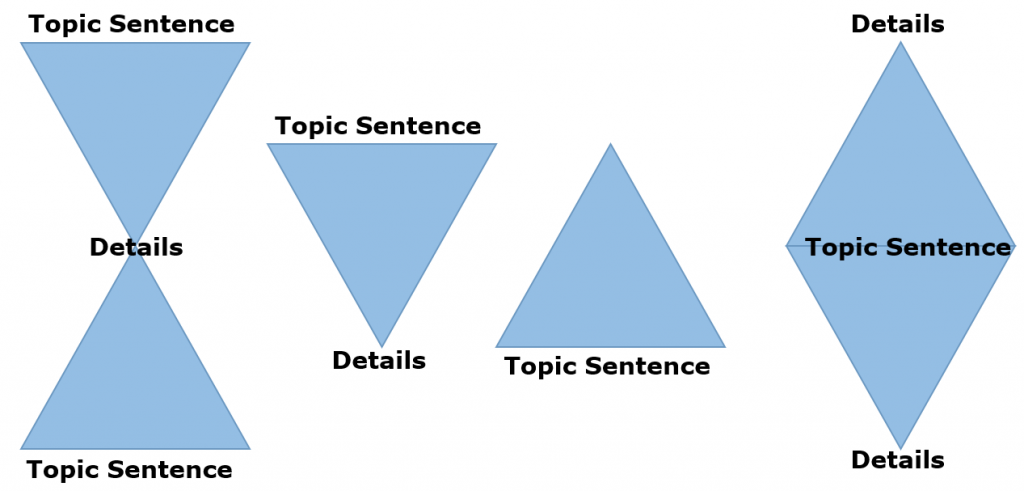9.4: Writing Paragraphs
- Page ID
- 22364
How to develop and organize paragraphs is a problem that plagues many beginning college writers. How do you start a paragraph? How can you help your reader understand the main idea? How do you know when you’ve included enough details? How do you conclude? You might also wonder when you need to break a paragraph and start a new one or how help your reader transition from one idea to the next. (For more on methods of development, see “Patterns of Organization and Methods of Development,” later in this “Drafting” section of this text.).
What Is a Paragraph?
Let’s begin by defining this concept of the paragraph. A paragraph is a group of sentences that present, develop, and support a single idea. That’s it. There’s no prescribed length or number of sentences. Paragraphs rarely stand alone, so most often the main topic of the paragraph serves the main concept or purpose of a larger whole; for example, the main idea of a paragraph in an essay should serve to develop and support the thesis of the essay. (For more on thesis statements, see “Finding the Thesis” earlier in this “Drafting” section of this text.)
Similarly, the main idea of a paragraph in a letter serves the overall purpose of the letter, whether that purpose is to thank your Aunt Martha for the thoughtful birthday sweater, or whether the purpose is to inform a local business that you’re dissatisfied with the quality of a product or service that you purchased.
Topic Sentences
The job of the topic sentence is to control the development and flow of the information contained in the paragraph. The topic sentence takes control of the more general topic of the paragraph and shapes it in the way that you choose to present it to your readers. It provides a way through a topic that is likely much broader than what you could ever cover in a paragraph, or even in an essay. This more focused idea, your topic sentence, helps you determine the parts of the topic that you want to illuminate for your readers—whether that’s a college essay or a thank you letter to your Aunt Martha. The following diagram illustrates how a topic sentence can provide more focus to the general topic at hand.

Think about some places where you might commonly find general topics presented with more focus, perhaps in news stories, textbooks, or speeches. The topic of a news story might be a deadly forest fire that’s burning out of control, while the focus of the topic might be about careless humans. The topic of a chapter from a medical text might be phlebotomy (the practice of drawing blood from a patient), while the focus of a section of that chapter might be about safe disposal of used needles. Maybe the topic of a persuasive speech is organic produce, while the focus of the speech is about the importance of supporting local organic farms.
Most topics are expansive, so they require more focus—whether in a thesis statement or a topic sentence—to provide a narrower view of the broader subject. This narrower and more focused view also often seeks to persuade the reader to see things from the writer’s perspective.
Side note. While we’re on the subject of speech class, let’s talk about how the presentation of topics in an academic essay differs from the presentation of topics in a speech. Beginning speech writers often use obvious verbal signposts to announce main ideas, transitional moments, or concluding thoughts.
For example, it would not be uncommon for a student in a college speech class, while delivering a speech, to say, “First, I will explain . . .” or “The first topic I will cover . . .” or “Next, I will tell you about . . .” or “In conclusion, as I have demonstrated . . . .” And while these methods for announcing a topic may be common and accepted practices in some college speech classes, they do not suit the expectations of your audience for an academic essay. With an oral presentation, the audience can’t see how the speech will unfold, but with written text, readers can see the size and shape of the document that they’re reading, so they don’t need as much help navigating.
So how can you correct this common problem? It’s quite simple actually. Just remove the verbal signpost that announces your position, remove the first person “I,” point of view and simply state the position or topic (see the “Point of View” section in the “Writing about Texts” portion of this text). Here’s an example:
Speech-like announcement of a topic: First, I will explain that while it’s a common belief that use of cell phones causes lower levels of concentration and focus, cell phone use does have a place in the classroom and smart phones should be considered a valuable educational tool.
Improved presentation of a topic: While it’s a common belief that the use of cell phones causes lower levels of concentration and focus, cell phone use does have a place in the classroom, and smart phones should be considered a valuable educational tool.
Placement of Topic Sentences
What if I told you that the topic sentence doesn’t necessarily need to be at the beginning? This might be contrary to what you’ve learned in previous English or writing classes, and that’s okay. Certainly, placing topic sentences at or near the beginning of paragraphs is a fine strategy, especially for beginning writers. If you announce a topic clearly and early on in a paragraph, your readers are likely to grasp your idea and to make the connections that you want them to make.
Now that you’re writing for a more sophisticated academic audience though—that is an audience of college-educated readers—you can use more sophisticated organizational strategies to build and reveal ideas in your writing. One way to think about a topic sentence, is that it presents the broadest view of what you want your readers to understand. This is to say that you’re providing a broad statement that either announces or brings into focus the purpose or the meaning for the details of the paragraph. And if you think of the topic sentence as the broadest view, then you can think about how every supporting detail brings a narrower—or more specific—view of the same topic.
With this in mind, take some time to contemplate the diagrams in the figure below. The widest point of each diagram (the bases of the triangles) represents the topic sentence of the paragraph. As details are presented, the topic becomes narrower and more focused. The topic can precede the details, it can follow them, it can both precede and follow them, or the details can surround the topic. There are surely more alternatives than those that are presented here, but this gives you an idea of some of the possible paragraph structures and possible placements for the topic sentence of a paragraph.

Consider some of the following examples of different topic sentence placements in a paragraph from a review essay of the beloved children’s book, The Cat in the Hat, by Dr. Seuss. Paragraph structures are labeled according to the diagrams presented above, and topic sentences are identified by red text.
Topic Sentence-Details-Topic Sentence
A good children’s book requires an exciting plot and a problem with which children can sympathize. In The Cat in the Hat there is plenty of action, depicted in the wild antics of the cat, and later in the amazing but dangerous and messy tricks of Thing 1 and Thing 2. All this excitement and action naturally draws children into the story and keeps the plot moving forward at a pace that maintains their interest. There is also tension to be resolved. The fish senses danger and constantly warns the children not to participate in the cat’s perilous stunts. And later, as the mother’s return becomes more imminent, the children begin to heed the fish’s warning and finally wish to contain the chaos and clean up the mess, but how? While this plot is fantastic enough to fuel any child’s imagination, it also contains a problem with which any child can relate: a mess and the threat of a parent’s disapproval. The careful balance of action, tension, and relatability is what makes this book an enduring childhood favorite.
Topic Sentence-Details
The careful balance of action, tension, and relatability is what makes Dr. Seuss’s The Cat in the Hat an enduring childhood favorite. In The Cat in the Hat there is plenty of action, depicted in the wild antics of the cat, and later in the amazing but dangerous and messy tricks of Thing 1 and Thing 2. All this excitement and action naturally draws children into the story and keeps the plot moving forward at a pace that maintains their interest. There is also tension to be resolved. The fish senses danger and constantly warns the children not to participate in the cat’s perilous stunts. And later, as the mother’s return becomes more imminent, the children begin to heed the fish’s warning and finally wish to contain the chaos and clean up the mess, but how? While this plot is fantastic enough to fuel any child’s imagination, it also contains a problem with which any child can relate: a mess and the threat of a parent’s disapproval.
Note: you can relocate the topic sentence to the end here, and you’ll have an example of the Details-Topic Sentence method of organizing the paragraph.
Details-Topic Sentence-Details
In The Cat in the Hat there is plenty of action, depicted in the wild antics of the cat, and later in the amazing but dangerous and messy tricks of Thing 1 and Thing 2. All this excitement and action naturally draws children into the story and keeps the plot moving forward at a pace that maintains their interest. The careful balance of action, tension, and relatability is what makes Dr. Seuss’s The Cat in the Hat an enduring childhood favorite. There is definitely tension to be resolved here. The fish senses danger and constantly warns the children not to participate in the cat’s perilous stunts. And later, as the mother’s return becomes more imminent, the children begin to heed the fish’s warning and finally wish to contain the chaos and clean up the mess, but how? While this plot is fantastic enough to fuel any child’s imagination, it also contains a problem with which any child can relate: a mess and the threat of a parent’s disapproval.
Implied Topic Sentences
Now that you’re getting used to the idea that the topic sentence doesn’t necessarily need to be placed at the beginning of the paragraph, what if I told you that, sometimes, the topic sentence doesn’t need to be stated at all? It’s true! Eliminating the topic sentence isn’t always the best strategy for beginning writers, but it can be effective, and it’s a pretty common strategy among professional writers. It’s also worthwhile to note that many instructors will prefer an explicit topic sentence over an implied one, just as many will prefer an explicit thesis over an implied one. When in doubt, ask your instructors about their preferences in areas such as these.
One area where you’re likely to find implied topic sentences is in narrative essays. In narratives, as in novels or other works of creative writing, readers often prefer to glean the meaning from the text rather than to have it thrust upon them. Writers also often prefer to imply themes and ideas rather than spelling it out for their readers. There are also times when your main idea will be obvious enough without having to come out and state your topic sentence. If you’re not sure about whether or not an implied topic is working in a paragraph, write an explicit topic sentence for the paragraph. Read the paragraph with and without your new explicit topic. Does addition of the explicit topic improve the clarity of the paragraph or essay? Share the essay with a couple of friends or classmates and get some second opinions.
Consider the following paragraph from an essay titled “The Bothersome Beauty of Pigeons,” by author and Boise State writing professor, Bruce Ballenger. It’s important to note that this is a personal narrative essay rather than a more traditional academic essay, but it the paragraph provides a good example of an implied topic. In this essay Ballenger takes the time to consider the beauty of pigeons, a bird that’s usually thought of as nothing more than a nuisance. Just prior to this paragraph, Ballenger talks about how he used a fake owl to scare away pigeons on his property. He goes on to explain
My pigeons moved next door where an elderly couple feed them bird seed and have the time and willingness to clean up after their new charges; so it seems, in this case, things have worked out for everyone. But the large flocks still haunt the piazzas in Florence and Venice, the squares in London, and similar places in nearly every city across the globe. Despite their ability to distinguish between a Van Gogh and a Chagall, pigeons still deposit droppings that deface the great marble statues and facades–the works of art and architecture that are part of our human heritage–and yet people still buy bags of seed for about a dollar and pose for photographs, drenched in doves. Meanwhile, officials in these cities continue, sometimes quietly, to wage war against the birds (“Introduction”).
Here, Ballenger seems to be saying that in spite of the attempts of so many to rid themselves of the pigeons, others are still drawn to them and will feed them and encourage them to come back. His main idea seems to be that the battle against pigeons is a losing proposition, but he doesn’t come out and say so. His message in this paragraph is implied. Do you think this paragraph would be improved with an explicit topic sentence? As you write and revise your own paragraphs, these will be important questions for you to consider about your own writing.
Characteristics of a Good Topic Sentence
If a reader or teacher comments that your paragraph lacks unity, you probably need a better topic sentence (or maybe you don’t have one yet). So, how can you spot a good topic sentence when you’ve written one? A good topic sentence might meet the following criteria:
- Signals the topic and also the more focused ideas of the paragraph
- Presents an idea or ideas that are clear and easy to understand
- Provides unity to the paragraph (so it’s clear how all supporting ideas relate)
- Omits supporting details
- Engages the reader
There’s no right order in the writing process for identifying or writing the topic sentence of a paragraph. Some writers begin drafting a paragraph with a main idea already in mind and then decide how to support it. Others begin writing about details, examples, or quotations from sources that they feel somehow relate to what they want to say, writing for a while before deciding what the main idea is. Most writers rely on a variety of strategies that they have developed through trial and error. So don’t let the lack of a main idea hold you back from getting out what you want to say. Write for a while, and a main idea will surely emerge.
Exercises
Here are some exercises to help you practice identifying and developing topics and topic sentences.
Identify the Topic and Focus
Choose a piece of writing, perhaps an essay or some news articles provided by your instructor, and for each paragraph identify (1) the topic and (2) the more focused idea. Remember, the topic sentence applies more focus to the broader topic to help narrow the scope of the paragraph. For example, the topic of a paragraph might be school lunches. The more focused idea of that same paragraph might be the idea of having students plant school gardens as a way to help incorporate more fresh produce in the menu.
Ask Readers to Find the Topic Sentences
Ask someone to read your essay and for each supporting paragraph, ask your reader to underline the most likely topic sentence. If your reader can’t find a topic sentence, ask him or her to write a topic sentence for that paragraph.
Ask a Readers to Share Their Expectations
Provide a reader with a list of your topic sentences, without the paragraphs that they belong to. Ask the reader what he or she thinks each paragraph is about and what kind of supporting details or discussion he or she would expect to see in the paragraph.


